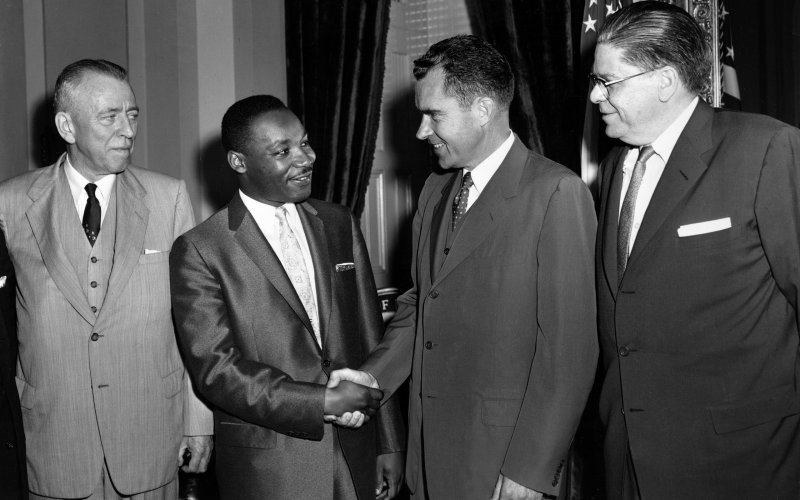Today marks what would have been Dr. Martin Luther King Jr.’s 88th birthday.
Presidential historian Irv Gellman details King’s relationship with then Vice President Nixon in his very insightful and revealing book, The President and the Apprentice: Eisenhower and Nixon, 1952-1961.
The two first met in March 1957 while on a trip to Ghana to celebrate the county’s independence from Great Britain. In June, King met again with Nixon at his Capitol Hill offices to discuss the administration’s Civil Rights efforts.
The reason for the meetings points to Nixon’s centrality in the Eisenhower administration as a chief advocate on rights for African Americans.
Nixon served as chairman of the President’s Committee on Government Contracts (PCGC) enforcing nondiscrimination in companies receiving federal contracts, and at the beginning of Eisenhower’s second term, the president tasked his vp with spearheading the Civil Rights Act of 1957. Nixon did so vigorously, battling high-ranking Southern democrats like Richard Russell of Georgia, and Senate Majority Leader Lyndon Johnson, maintaining that he had a sworn duty to “support legislation which will guarantee the right of all of our citizens to vote, regardless of their race, creed or color.”
Eisenhower’s originally proposed bill called for the creation of a Civil Rights Commission and a Civil Rights division in the Department of Justice. The other two main pillars, giving the federal government authority to enforce school desegregation, and the authority to prosecute voting violations, fell victim to opposition attacks. David Nichols, author of A Matter of Justice: Eisenhower and the Beginning of the Civil Rights Revolution, explained their demise in a 2007 New York Times op-ed:
The Eisenhower proposal had four main parts. The first two — the creation of a civil rights commission to investigate voting irregularities and a civil rights division in the Justice Department — survive to this day. The other two pillars, unfortunately, became victims of politics. Part 3 proposed to grant the attorney general unprecedented authority to file suits to protect broad constitutional rights, including school desegregation. Part 4 provided for federal civil suits to prosecute voting rights violations.
Senator Richard Russell of Georgia led the attack on Part 3, accusing the attorney general of conspiring “to destroy the system of separation of the races in the Southern states at the point of a bayonet.” Johnson eventually told Eisenhower he had the votes to kill the entire bill unless the president dropped Part 3. Eisenhower reluctantly capitulated.
The reasoning behind the fourth part of the proposal, providing for civil suits, was that in 1957, civil rights prosecutions were carried out by the criminal division of the Justice Department, and offenses would be subject to jury trials. Given the all-white juries of the South, prosecutions were acts in futility. Thus Eisenhower and Brownell wanted to open these cases to civil suits, without a jury, that could result in a court order and, if resisted, a contempt citation.
Southerners insisted that these civil suits would be criminal trials in disguise, denying defendants their constitutional right to a trial by jury. So on Aug. 1 Johnson and his fellow Southerners succeeded in passing an amendment to the bill requiring juries in such civil trials.
Though the legislation wasn’t strong as originally proposed, King told Nixon that “it is much better than no bill at all.”
“We can at least be sure that we are moving steadily and ahead,” King concluded.
And so they did.
The 1957 bill became the basis for a second piece of legislation in 1960, and ultimately the landmark Civil Rights Act of 1964 and the Voting Rights Act of 1965.
Listen to a Nixon Now Podcast with Dr. Gellman for an in depth look on Nixon’s relationship with Dr. King and his legacy on civil rights:
Photo Credit: Henry Griffin/AP

